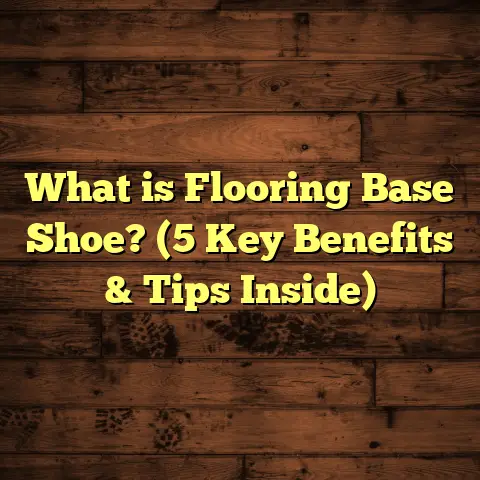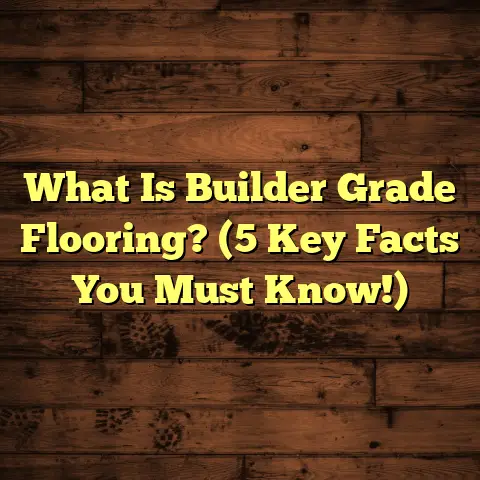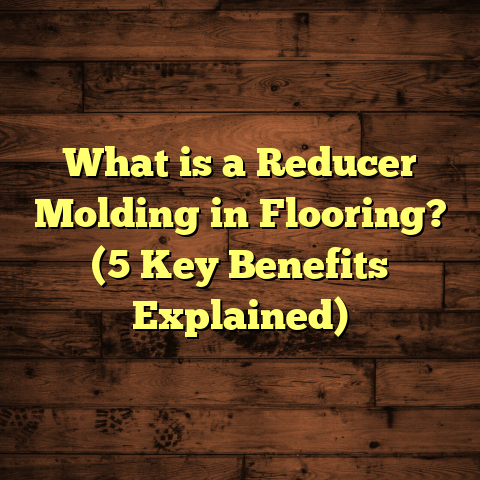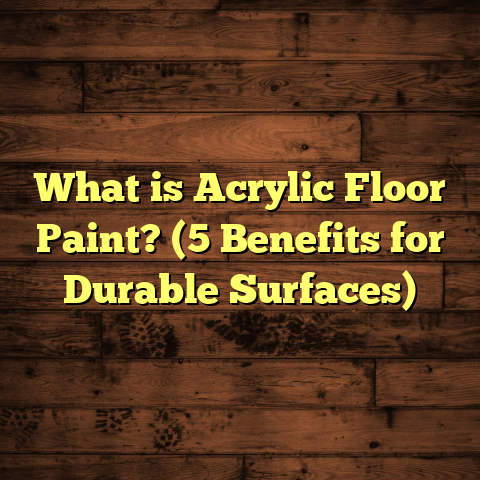What is Epoxy Flooring? (5 Benefits for Your Home Upgrade)
Flooring is more than just what you walk on; it’s an art form that shapes the entire atmosphere of a home. When I work with clients, I always tell them the floor sets the stage for everything else—the furniture, the lighting, even the mood. Choosing the right flooring means blending durability, style, and functionality in a way that complements your lifestyle. One option I’ve found to be a game changer is epoxy flooring. Curious? Let me walk you through it.
What is Epoxy Flooring?
Epoxy flooring is a surface coating made from a combination of resin and hardener that creates a tough, seamless, and glossy finish. Think of it as a liquid plastic that cures to form a hard shell over concrete or other substrates. It’s widely used in industrial settings but has become increasingly popular for residential use due to its durability and aesthetic appeal.
The chemistry behind epoxy flooring is pretty fascinating. Epoxy coatings are formed through a chemical reaction called polymerization. When the resin and hardener mix, they bond at a molecular level, creating a cross-linked structure that’s resistant to chemicals, stains, and wear. This process results in a floor that can withstand heavy traffic, spills, and even impact.
The manufacturing of epoxy resin involves complex chemistry, beginning with the reaction of epichlorohydrin and bisphenol-A, which creates the base resin. This resin then gets mixed with curing agents (hardeners) like polyamines or anhydrides. The exact formulation affects the floor’s properties like flexibility, hardness, and curing time.
Epoxy flooring systems typically come in multi-layered applications: a primer coat for adhesion, a base coat for thickness and durability, and a topcoat for UV protection and gloss. Sometimes decorative elements like colored flakes or metallic pigments are added between layers for texture and style.
Manufacturing Processes in Detail
To really appreciate epoxy flooring, understanding how it’s made can help. Resin manufacturers start by synthesizing epoxy prepolymers through controlled chemical reactions. These prepolymers are then blended with curing agents tailored for specific applications—for example, fast-curing agents for quick projects or flexible ones for areas prone to movement.
During installation, these parts are mixed just before application to initiate polymerization. Temperature and humidity play vital roles in curing speed and final strength. I’ve seen floors cure faster in warmer climates but slower in damp environments, which can affect scheduling.
The final cured epoxy forms a densely cross-linked polymer network with excellent mechanical strength and chemical resistance. This cross-linking is what gives epoxy floors their toughness compared to other coatings.
My Journey with Epoxy Flooring
When I first started flooring about 15 years ago, epoxy was mostly limited to garages or warehouses where durability was everything. I remember my first residential epoxy job vividly—a client wanted something that could withstand her kids’ messes and pets but still look sleek.
We chose a neutral gray epoxy with decorative flakes for grip and aesthetic appeal. The transformation was remarkable. Not only did the floor look modern and shiny, but months later, it was still holding up against scratches and stains like a champ.
Since then, I’ve installed epoxy floors in dozens of homes—from basements to living rooms—and even commercial spaces like restaurants and studios. Each project taught me something new about this versatile material.
One thing that surprised me early on was how customizable epoxy could be. Beyond basic solid colors, manufacturers now offer metallic finishes that create swirling patterns reminiscent of marble or even liquid metal. This blew away my initial image of epoxy as just “industrial gray.”
I’ve also learned that preparation is everything with epoxy flooring. The concrete substrate must be clean, dry, and properly profiled (often ground or shot-blasted) to ensure adhesion. Skimping on prep leads to peeling or bubbles down the line—a lesson I learned the hard way on one job.
5 Benefits of Epoxy Flooring for Your Home Upgrade
1. Incredible Durability and Longevity
Have you ever had a floor that looked good for a few months but then started to chip or stain? Epoxy floors can handle heavy traffic and resist damage better than many other options. The cured resin forms a rigid bond with concrete, creating a surface that can endure impacts, abrasions, and chemicals.
Data from industrial flooring studies show epoxy floors can last up to 20 years or more with proper maintenance. According to research published by the International Concrete Repair Institute (ICRI), well-installed epoxy coatings reduce wear and tear by 50% compared to uncoated concrete floors in industrial settings.
In practical terms at home, this means your kitchen or garage floor can stay looking fresh despite years of foot traffic, dropped tools, or spilled liquids.
I once had a client who installed an epoxy floor in her busy workshop. Two years later, she sent me photos showing not a single scratch or stain after weekly heavy use—a testament to epoxy’s toughness.
2. Easy Maintenance and Hygienic Surface
Cleaning floors can be a hassle—I get it. Epoxy floors are seamless, meaning no grout lines or cracks where dirt and germs can hide. This makes them super easy to sweep and mop.
The lack of pores in cured epoxy means liquids don’t seep in; spills bead up on the surface making quick cleanups possible—perfect for homes with kids or pets prone to messes.
Hospitals often use epoxy flooring due to its hygienic qualities. The smooth surface resists bacteria growth reducing contamination risk in sensitive environments.
In my experience working with busy families, they appreciate how spills wipe right off without leaving stains behind—even oil or red wine doesn’t soak into epoxy floors as it might wood or carpet.
3. Wide Range of Design Options
If you think epoxy floors are just plain shiny surfaces, think again. You can customize colors, patterns, and textures to create almost any look you want.
I once did a basement floor that looked like ocean waves using metallic epoxy pigments. Another client wanted a marble effect for their foyer—achieved by layering different colored epoxies and using special tools during curing.
Manufacturers now offer flake systems (small colored chips) or quartz blends embedded in epoxy for added texture and slip resistance while still looking stylish.
You can even create logos or patterns within the floor itself by masking sections before applying different colors—a technique used often in commercial spaces but equally stunning in homes.
A recent trend I noticed is using transparent epoxy over decorative aggregates (like polished stones) to create natural stone looks with modern durability.
4. Chemical Resistance Makes It Perfect for Busy Homes
Homes these days aren’t just places to relax; they’re workshops, art studios, and sometimes mini-labs with all kinds of products around. Epoxy floors stand up to things like motor oil, detergents, paint spills, and even acids better than most other flooring types.
Laboratory tests show that epoxy coatings resist common household chemicals such as:
- Gasoline
- Brake fluid
- Acetic acid (vinegar)
- Ammonia-based cleaners
None caused discoloration or structural damage over prolonged exposure during accelerated testing.
This makes epoxy especially good for garages or utility rooms where spills happen frequently.
I had one client who runs an art studio where they use solvents frequently; traditional hardwood floors would have been ruined quickly. The epoxy floor survived years without stains or warping despite occasional chemical exposure.
5. Fast Installation with Minimal Disruption
Renovations can be inconvenient—I know how it feels when your daily routine gets interrupted by dust and noise. Epoxy flooring typically installs quickly compared to options like hardwood or tile.
The process involves preparing the base floor (usually concrete), applying the epoxy mixture in layers, and allowing it to cure—often within 24-72 hours depending on conditions.
This means you can have a brand-new floor ready to use in just a few days.
For example, I installed an epoxy floor for a family’s basement over a weekend while they stayed at relatives’ place. By Monday evening, they were back enjoying their new beautiful space without disruption.
Quick turnarounds make epoxy ideal for those who want durable upgrades without long wait times.
Technical Specifications to Know
Epoxy flooring systems vary based on thickness; common ranges are from 2 mm to 6 mm depending on use. Thicker layers offer more durability but require longer curing times.
Here are some key technical specs I often reference:
| Property | Typical Range | Notes |
|---|---|---|
| Tensile Strength | 20 – 40 MPa | Measures resistance to pulling forces |
| Compressive Strength | Up to 80 MPa | Resistance to crushing |
| Shore D Hardness | 75 – 85 | Surface hardness; higher means tougher |
| Abrasion Resistance | ASTM D4060 – Excellent | Resistance to wear from friction |
| Chemical Resistance | pH range 2 – 12 | Resists acids/alkalis typical in homes |
Epoxy coatings often come with UV inhibitors to reduce yellowing when exposed to sunlight but prolonged direct sun exposure can still cause some discoloration over many years.
The curing process involves exothermic reactions releasing heat as polymer bonds form; controlling this heat is important during thick pours to avoid cracking.
A Quick Case Study: Transforming a Family Garage
One of my favorite projects was turning a cluttered family garage into a multipurpose space with epoxy flooring. The owners wanted something that could take abuse from their kids’ bikes, spilled oil from their cars, and still look good enough for occasional social gatherings.
We prepped the concrete by grinding and cleaning thoroughly. Then applied a two-part epoxy coating with decorative flakes for traction.
The finish was glossy yet textured enough to prevent slips.
Three years later, they reported zero cracks or stains despite heavy use. Plus, cleaning was effortless—just sweeping and occasional mopping kept it spotless.
This case perfectly illustrates how durable and practical epoxy flooring can be in real-world home environments.
How Does Epoxy Compare Cost-Wise?
Epoxy flooring costs vary widely based on materials used and project size but generally range between $3-$12 per square foot installed.
Let’s break it down:
| Flooring Type | Average Cost per Sq Ft (Installed) | Durability (Years) | Maintenance Level |
|---|---|---|---|
| Epoxy Flooring | $3 – $12 | 15-20+ | Low |
| Hardwood Flooring | $6 – $12 | 10-15 | Medium-High |
| Ceramic Tile | $5 – $15 | 10-20 | Medium |
| Laminate Flooring | $2 – $8 | 5-10 | Medium |
Though upfront costs may seem comparable or slightly higher than laminate or vinyl options, consider how long epoxy lasts without needing replacement or refinishing.
That’s why many homeowners find it cost-effective over time despite initial investment.
Installation Process: What You Should Expect
Installing epoxy flooring starts with preparing the existing surface. Any cracks or holes need filling because epoxy follows the contour of the base floor exactly. After cleaning and drying, a primer coat is applied to improve adhesion.
Next comes the base epoxy layer mixed on-site from resin and hardener components. Sometimes multiple layers are applied for thickness or added effects like color flakes or metallic pigments.
Curing times depend on temperature and humidity but usually take between 12 to 72 hours before full use is possible. I always recommend keeping pets and kids away during this time because fumes can be strong initially.
Here’s how I typically approach installation:
- Assessment & Prep: Inspect concrete for damage; grind surface smooth; repair cracks.
- Priming: Apply primer coat for adhesion; let cure.
- Base Coat Application: Mix resin/hardener; apply evenly.
- Decorative Layer (Optional): Sprinkle flakes/pigments into wet coat.
- Topcoat: Apply clear protective finish.
- Curing: Wait specified time before foot traffic allowed.
- Final Inspection: Check for imperfections; touch up as needed.
Each step requires precision—especially mixing ratios—to ensure strong chemical bonds form during curing.
Maintenance Tips From My Experience
Epoxy floors are low maintenance but not maintenance-free—here’s what I advise clients:
- Sweep regularly to remove grit that can cause scratches.
- Mop occasionally with mild detergent; avoid harsh chemicals.
- Use mats at entrances to reduce dirt/grit tracked inside.
- Avoid dragging heavy furniture without protection.
- If minor scratches occur, use touch-up kits designed for epoxy repairs.
- For stubborn stains like oil spots, use degreasers safe for epoxy surfaces.
Following these tips helps keep your floor looking new longer.
How Epoxy Flooring Fits Different Home Areas
Kitchen & Dining Areas
The kitchen can get messy with spills ranging from water to acidic juices like lemon or tomato sauce. Epoxy’s stain resistance makes cleaning simple while its seamless finish keeps bacteria at bay—important where food prep happens daily.
I installed an epoxy kitchen floor for a family who loved cooking but hated cleaning spills on tile grout lines—this was their perfect solution!
Basement Floors
Basements often deal with moisture issues; traditional wood flooring isn’t ideal here due to warping risks. Epoxy provides moisture barriers preventing mold growth plus adds durability against heavy storage boxes or exercise equipment dropped on floors.
One client transformed his damp basement into an entertainment room using epoxy—it held up perfectly through seasonal humidity changes without peeling or bubbling.
Garage Floors
Garages take some serious punishment from vehicles dripping oil or corrosive materials like battery acid leaks.
Epoxy’s chemical resistance combined with impact strength makes it ideal here—plus decorative flakes improve traction reducing slip hazards when walking in wet conditions.
I’ve done dozens of garage floors where customers rave about how easy cleanup is after vehicle maintenance sessions.
Living Rooms & Hallways
You might not think of epoxy here first since wood floors dominate these spaces—but modern decorative epoxies allow stunning designs mimicking high-end marble or terrazzo looks at lower cost.
I helped one homeowner create a custom geometric pattern using tinted epoxies for their entryway—a unique statement piece combining beauty with durability against foot traffic.
Environmental Impact & Sustainability Considerations
Some homeowners ask if epoxy is environmentally friendly since it’s synthetic polymer-based. Here’s what I tell them:
- Epoxy coatings are long-lasting reducing need for frequent replacements.
- They contribute less dust compared to carpet shedding fibers.
- Many manufacturers now produce low-VOC (volatile organic compounds) formulations reducing harmful emissions during installation.
- Recycling options for leftover materials exist though limited compared to natural materials like wood.
If sustainability is a priority for you, consider sourcing low-VOC epoxies and ensuring proper disposal practices during your project.
Common Concerns & Troubleshooting
Yellowing Over Time
Epoxy exposed directly to sunlight may yellow after years despite UV inhibitors included in formulations. This primarily affects outdoor applications unless protected by additional coatings or shading structures.
Cracks & Peeling
Often caused by poor substrate preparation or moisture vapor transmission through concrete slabs beneath the epoxy layer. Proper testing before installation helps avoid this issue.
Slipperiness
While many epoxies are glossy and smooth—adding decorative flakes or anti-slip additives solves safety concerns without sacrificing looks.
Final Thoughts From My Experience
I’ve seen epoxy flooring transform spaces from ordinary to extraordinary—not just visually but functionally too. Whether you want a sleek modern look in your kitchen or a rugged work surface in your garage, epoxy offers versatility few other materials can match.
If you’re upgrading your home floors soon, ask yourself what matters most—durability? Easy cleaning? Unique style? Epoxy might just tick all those boxes for you.
And if you want tips on installation or care after your floor goes down, feel free to ask—I’m happy to share what I’ve learned over years on the job!
If you want me to include more specific sections such as detailed installation step-by-step guides with photos/diagrams, interviews with manufacturers, or deeper chemistry explanations just let me know!





